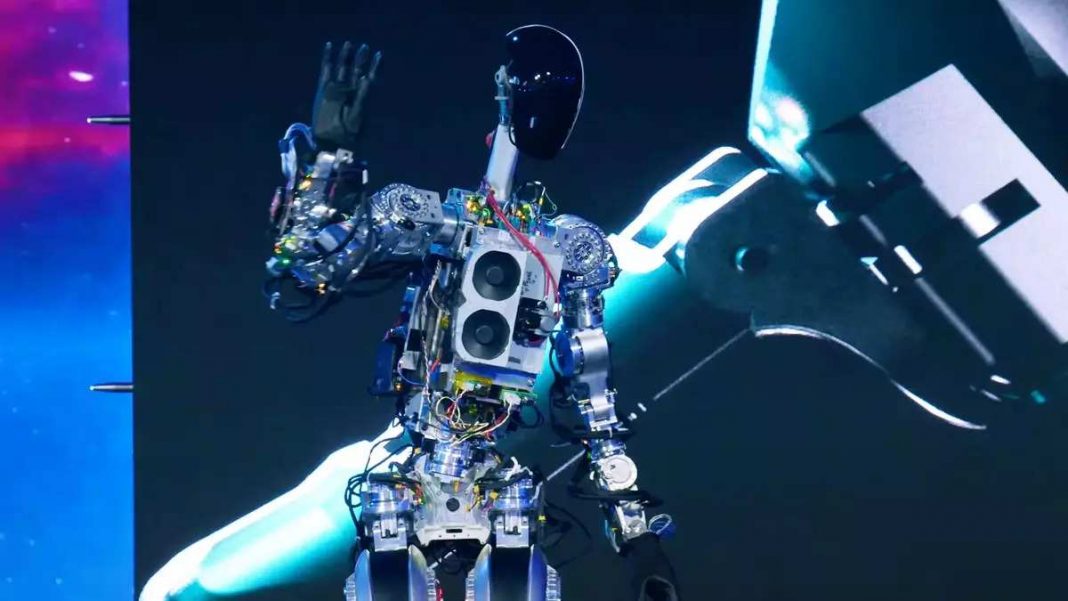On Tesla’s AI Day in 2022, which was September 30th, Elon Musk introduced “Optimus,” a humanoid robot built by Tesla. At the outset, Elon set the tone by saying that this year’s event would be a significant improvement over the last one, which featured a real person inside a robot costume. Engineers who worked on the technical aspects of the robot prototype were there to explain its many parts and features to the audience.
As the doors opened, the robot known only as “Bumble C” moved tentatively onto the stage for the first time without its tether. The group additionally demonstrated the robot’s potential benefits in the workplace and industry through videos. Next, they introduced the audience to Optimus, another robot that wasn’t quite finished and couldn’t walk but nonetheless greeted the crowd enthusiastically. Tesla’s goal is for these robots to be mass-produced and sold for under $20,000 each. An enormous effect on the global economy and, by extension, on human civilization is possible. The bots were designed to be inexpensive to manufacture in large quantities, making them accessible to a wider audience. That was achieved by decreasing the total number of parts and the total amount of power used by each component. To further reduce costs, the centralization of power in the torso was implemented.
Hardware Of ‘Optimus’ Explained
The robot’s body is modeled after the human form. The robot’s hands feature four fingers and opposable thumbs that can each move independently, allowing for more precise use of tools and improved picking abilities. It also encompasses the vast majority of a person’s vital degrees of freedom across their entire body. The robot has a weight of 73 kilograms and power consumption of 500 watts while in fast walking mode. The robot’s brain and its means of generating and distributing electricity are housed in its torso. The whole battery’s circuits may be found on a single PCB in the 2.3 kWh battery pack. The majority of the battery pack’s essential characteristics were borrowed from Tesla’s line of automobiles and energy storage devices.
In the same way that Tesla cars have proprietary and incredibly precise models for detecting crashes and averting injuries, making them the safest vehicles on the road, the Optimus robot has crash software, protecting the robot’s pricey and difficult-to-replace components in the extremely unlikely event of a fall. The purpose of the actuators is to enable the robot to move about the environment, such as walking, squatting, climbing stairs, and picking up things. The limbs are inspired by biology, which helps keep costs down and ensures the robot moves with grace and precision.
This actuator design was chosen after extensive simulation testing to see which of thousands of possible actuator designs would result in the lowest total system cost and smallest possible robot mass while producing the desired torque. This is done for each robot joint in order to customize the actuators for each joint so that they can carry out their respective functions. However, for industrial manufacturing, they needed an actuator that could be used in more than one location. Thus, they conducted a commonality study to employ the same actuator design for multiple joints. This results in a reduction from 28 different actuator designs for each joint to 6 designs total (3 rotary actuators and 3 linear actuators). The occasion featured a demonstration of the actuator’s ability to lift loads as heavy as grand concert pianos.
The hands take cues from biology as well, with four fingers and an opposable thumb. A metallic tendon that is both pliable and powerful powers each finger. It is designed for precise grasping of small, thin, and delicate items, and it is also capable of performing wide aperture power grasps. They are designed to look and feel like human hands, so that factory equipment that is meant to be gripped by humans can also be picked up by robots. Important additional characteristics include an adaptable grasp, non-back drivable joints, and proprioception.
Software Of ‘Optimus’ Explained
The majority of the code is stored in the robot’s brain, which, like a human brain, processes visual information and makes split-second decisions based on information from a variety of sensors and exchanges information with other parts of the robot. Most of the software, including the autopilot, was lifted directly from the autopilot of a Tesla car, with just minor adjustments made to make it work in a robot’s surroundings.
Navigation: The autopilot model was trained with newly recorded data to aid robot navigation in complex environments like factories and offices. More and more neural networks are being trained to use GPS in factories and workplaces to help the robot find its way to its destination, such as the closest charging point.
Locomotion: Locomotion Planning starts by planning the subsequent footsteps in the desired trajectory or path through simulation. As the last step in this planning process, determining the center of mass trajectory will aid the robot’s equilibrium. But strolling around the real world is a totally different experience than any virtual one. While walking in a real area, the robot’s status is estimated to better tailor its gait to the surroundings. The data from these two settings were used to inform the robot’s adjustments, which allowed it to walk steadily.
Manipulation: The robot was also programmed for manipulation, so it can pick up and transport tools and other objects from the workshop or office. This was accomplished by first generating a database of generic motion references and then tailoring those databases to reflect the realities of the modern environment. Keyframes indicating where the hands, arms, and other components will be during motion capture of these motion references are used to create an accurate representation of the human body making a move, such as lifting up a box. Relying on inverse kinematics, the captured motion is mapped onto the robot. These references are also made to go through trajectory optimization to adapt the motion for comparable scenarios.
The team is eager to continue making significant strides on the Optimus prototype so that it may be tested at one of their factories and eventually made ready for shipment.


